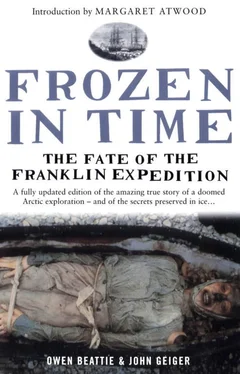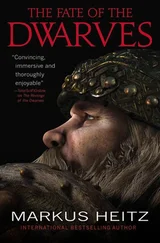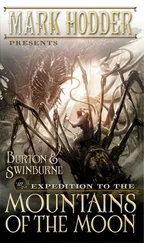James Fitzjames, Captain HMS Erebus. F.R.M. Crozier Captain and Senior Offr. and start on tomorrow 26th for Backs Fish River.
“So sad a tale was never told in fewer words,” M’Clintock commented after examining the note. Indeed, everything had changed in the eleven months between the two messages. Beset by pack-ice since September 1846, Franklin’s two ships ought to have been freed during the brief summer of 1847, allowing them to continue their push to the western exit of the passage at Bering Strait. Instead, they remained frozen fast and had been forced to spend a second winter off King William Island. For the Franklin expedition, this was the death warrant. There had already been an astonishing mortality rate, especially among officers. Deserting their ships on 22 April 1848, the 105 surviving officers and men set up camp on the northwest coast of King William Island, preparing for a trek south to the mouth of the Back River, then an arduous ascent to a distant Hudson’s Bay Company post, Fort Resolution, which lay some 1,250 miles (2,210 km) away. M’Clintock described the scene where the note had been discovered:
Around the cairn a vast quantity of clothing and stores of all sorts lay strewed about, as if at this spot every article was thrown away which could possibly be dispensed with—such as pickaxes, shovels, boats, cooking stoves, ironwork, rope, blocks, canvas, instruments, oars and medicine-chest.
The notes found in the cairn at Victory Point on 5 May 1859, by Lieutenant Hobson and his men.
Why some of these items had been carried even as far as Victory Point is another of the questions that cannot be answered, but M’Clintock was sure of one thing: “our doomed and scurvy-stricken countrymen calmly prepared themselves to struggle manfully for life.” The magnitude of the endeavour facing the crews must have been overwhelming, and the knowledge of its futility spiritually crushing. It also ran contrary to the best guesses of other leading Arctic explorers. George Back, who had explored the river named for him in 1834, was certain Franklin’s men would not have attempted an escape over the mainland: “I can say from experience that no toilworn and exhausted party could have the least chance of existence by going there.” John Rae thought that “Sir John Franklin would have followed the route taken by Sir John Ross in escaping from Regent Inlet.”
To this day, the route of the expedition retreat confounds some historians, who, like Rae, believe a much more logical and attainable goal would have been to march north and east to Somerset Island and Fury Beach—the route by which John Ross had made good an escape from an ice-bound ship in 1833. Fury Beach was not much further for the crews of the Erebus and the Terror than it had been for John Ross’s crew of the abandoned Victory. It was also the most obvious place for a relief expedition to be sent, and James Clark Ross did indeed reach the area with two ships, five months after the Erebus and Terror were deserted.
Instead, after quitting their camp on 26 April, the crews moved south along the coastline of King William Island, man-hauling heavily laden lifeboats that had been removed from the ships and mounted on large sledges. Plagued by their rapidly deteriorating health, the crews were then overcome by the physical demands of the task. M’Clintock found what appeared to have been a field hospital established by Franklin’s retreating crews only eighty miles into their trek. He suspected scurvy. Speculation also focussed on the tinned food supply. Inuit later told of some of their people eating the contents of the tins “and it had made them very ill: indeed some had actually died.” As for Franklin’s men, many died along the west and south coasts of King William Island.
Later, Hobson found a vivid indication of the tragedy when he located a lifeboat from the Franklin expedition containing skeletons and relics. Men from Franklin’s crews had at last been found, but the help had come a decade too late. When M’Clintock later visited the “boat place,” he described his tiny party as being “transfixed with awe” at the sight of the two human skeletons that lay inside the boat. One skeleton, found in the bow, had been partly destroyed by “large and powerful animals, probably wolves,” M’Clintock guessed. But the other skeleton remained untouched, “enveloped with cloths and furs,” feet tucked into warm boots to protect against the harsh Arctic cold. Nearby were two loaded double-barrelled guns, as if ready to fend off an attack that never came.
M’Clintock named the area, on the western extreme of King William Island, Cape Crozier. The boat, which had been carefully equipped for the ascent of the Back River, was 28 feet (8.5 metres) long; M’Clintock estimated the combined weight of the boat and the oak sledge it was mounted on at 1,400 pounds (635 kg).
Careful lists of the “amazing” quantity of goods also contained in the boat were compiled. Everything from boots and silk handkerchiefs to curtain rods, silverware, scented soap, sponges, slippers, toothbrushes and hair-combs were found. Six books, including a Bible in which most of the verses were underlined, A Manual of Private Devotions and The Vicar of Wakefield, were also discovered and scoured for messages, but none were found. The only provisions in the boat were tea and chocolate. M’Clintock judged the astonishing variety of articles “a mere accumulation of dead weight, of little use, and very likely to break down the strength of the sledge-crews.” Perhaps strangest of all was the direction in which the boat was pointing, for instead of heading towards the river that was the target of the struggling survivors, the boat was pointed back towards the deserted ships. M’Clintock guessed that the party had broken off from the main body of men under the command of Crozier, and was making a failed attempt to return to the ships for food: “Whether it was the intention of this boat party to await the result of another season in the ships, or to follow the track of the main body to the Great Fish [Back] River, is now a matter of conjecture.”
M’Clintock discovers a lifeboat—containing skeletons—from the Franklin expedition.
This picture, of dying seamen shambling along, dragging sledges loaded down with the detritus of Victorian England, is the enduring image of the Franklin expedition disaster. Reviewing the evidence in 1881, M’Clintock concluded that surviving members of Franklin’s expedition:
…were far gone with scurvy when they landed; and the change from the confined lower decks, and inaction, to extreme exposure in an Arctic temperature, combined with intensely hard sledging labour, would almost immediately mature even incipient scurvy. The hospital tent within 80 miles [130 km] of the spot where their march commenced is, I think, conclusive proof of this. The Investigator [McClure’s search expedition] is almost the only ship which has ever similarly spent three winters in the ice. Although she had only three deaths in all that time, yet a careful medical examination revealed the fact that only 4 out of a total of 64 on board were not more or less affected by scurvy. Such is the usual results of limitation to salted or preserved provisions, unrelieved by fresh animal or vegetable food. It is evident that disease, not starvation, carried off the earliest and by far the largest number of Franklin’s companions, those martyrs to the cause of geographical discovery.
Even among his own sledging parties, M’Clintock observed, “scurvy advanced with rapid strides.” Hobson, who had carried tinned pemmican for food, “suffered very severely in health,” ultimately having to be dragged back on the sledge. Wrote M’Clintock of Hobson’s plight: “How strongly this bears upon the last sad march of [Franklin’s] lost crews!” Years later, Hobson was asked: “Can you give… any opinion as to the cause why scurvy broke out with you?” His answer was, “I can scarcely say that scurvy did break out with us. I said that the men were debilitated, that they lost stamina. There was no cause that I know of, except the fact of not being able to get really fresh meat and fresh vegetables.”
Читать дальше










